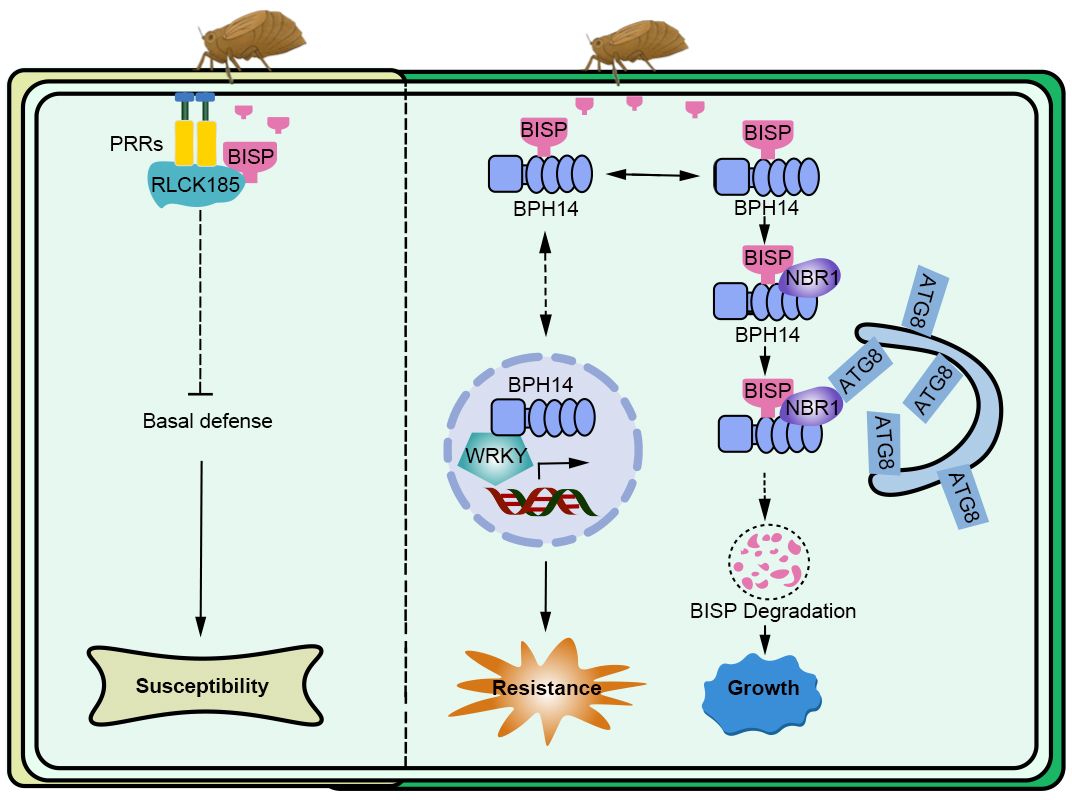On June 14, the leading international journal Nature published an article revealing research findings on the molecular mechanisms of rice plants’ resistance to brown planthopper by Professor He Guangcun’s research group from the State Key Laboratory of Hybrid Rice, College of Life Sciences, Wuhan University.
The paper, entitled A tripartite rheostat controls self-regulated host plant resistance to insects, was the first to identify an insect effector BISP recognized by plant immune receptor proteins and uncover the molecular mechanisms of BISP-BPH14-OsNBR1 interaction in finely regulating rice insect resistance response, which is of great significance for the cultivation of high-yield and insect-resistant rice varieties.
The study received financial support from several sources. Postdoctoral student Guo Jianping, Ph.D students Wang Huiying and Guan Wei (College of Life Sciences, Wuhan University) are co-first authors of the paper, with Professor He Guangcun as the corresponding author. Academician Zhang Qiqi (Huazhong Agricultural University), Academician Zhu Yuxian (Wuhan University), Professor Walling (University of California, Riverside) and members of the research group participated in the study.
Brown planthopper is the most widely occurring pest in rice production, causing the greatest loss and jeopardizing global rice production. Cultivating insect-resistant varieties is the most economical, effective and environmentally friendly means to control this pest, but the molecular mechanism of plants’ resistance to insects has been vague.
Professor He's research group screened and obtained brown planthopper’s salivary protein BISP (BPH14-Interacting Salivary Protein), unveiling the molecular mechanism of pest feeding and plant counterfeeding for the first time. The research found that BISP is highly expressed in salivary glands of brown planthoppers, which enter rice cells with saliva secretion when feeding. In rice susceptible to brown planthoppers, BISP targets the rice plant’s kinase OsRLCK185, interferes with its kinase activity and inhibits the basal defense response of the rice, making the plant easier for brown planthopper to feed. In the early stage, the research group cloned the anti-brown planthopper gene Bph14, the NLR receptor of which is BPH14 and conferred it on rice high resistance to brown planthopper. In insect-resistant rice (Bph14 rice) containing the Bph14 gene, BISP is recognized immediately by specific binding to BPH14 after entering the cell, which stimulates a strong insect resistance response, and reduces the feeding of brown planthopper, hinders its growth, and increases mortality, thereby preventing the invasion of brown planthopper.
In this study, when BISP (Bph14-Bisp rice) was expressed ectopically in Bph14 rice, the over-expressed BISP would constitutively activate the BPH14-mediated resistance response, causing Bph14-Bisp rice to produce stronger insect resistance. However, compared with Bph14 rice, the growth and development of Bph14-Bisp rice have been seriously affected: the Bph14-Bisp plant becomes smaller, with the heading stage advanced and lower yields. This suggests that the constitutive activation of strong resistance negatively affects the plant’s growth, and the level of resistance in the plant needs to be tightly controlled to maintain the balance of its growth and resistance.

Working mode of BPH14-mediated rice immune response
Further studies have found that when BPH14 was co-expressed with BISP in rice cells, BPH14 can promote the interaction between BISP and selective autophagy receptor OsNBR1, while OsNBR1 binds to ATG8 and mediates the autophagy degradation of BISP, thereby controlling the amount of BISP protein and plant resistance at a certain level. BPH14 plays a crucial role in identifying BISP to stimulate anti-insect response and three-protein interaction to regulate autophagy to clear BISP. When pests feed, the BPH14-BISP-NBR1 three-protein interaction system can quickly remove the remaining BISP in rice cells, terminate the resistance reaction, and enable cells to resume growth as soon as possible. The level of BISP in Bph14 rice cells decreased significantly within 6 hours and completely degraded at 36 hours, and the insect resistance response was weakened until it was terminated. In OsNBR1-knockout plants (Bph14-Osnbr1), BISP protein retention and resistance response remained at a high level for a long time. BPH14 degrades BISP through autophagy, effectively controls the level of BISP and resistance in rice cells, and maintains the balance between insect resistance and the growth of the cells. The discovery of the new mechanism is a major advance in the field of plants’ resistance to insects.
Professor He Guangcun's team for the first time explained the molecular mechanism of BISP-BPH14-OsNBR1 three-protein interaction in controlling plants’ insect resistance response and proposed a new strategy to reach insect resistance in breeding without reducing yields, which is of great significance for achieving insect resistance and high yields in rice breeding.

Professor He Guangcun

Professor He Guangcun’s research group
Article Link: https://www.nature.com/articles/s41586-023-06197-z
Rewritten by Zhang Ruoxi
Edited by Jiang Hanjun